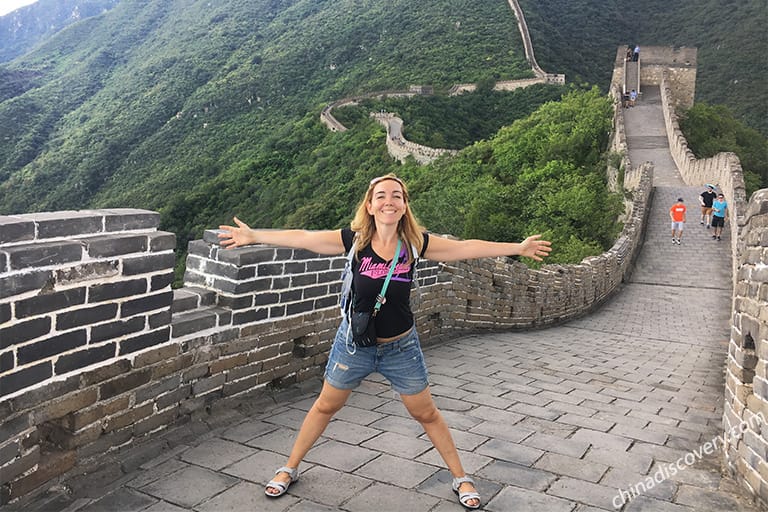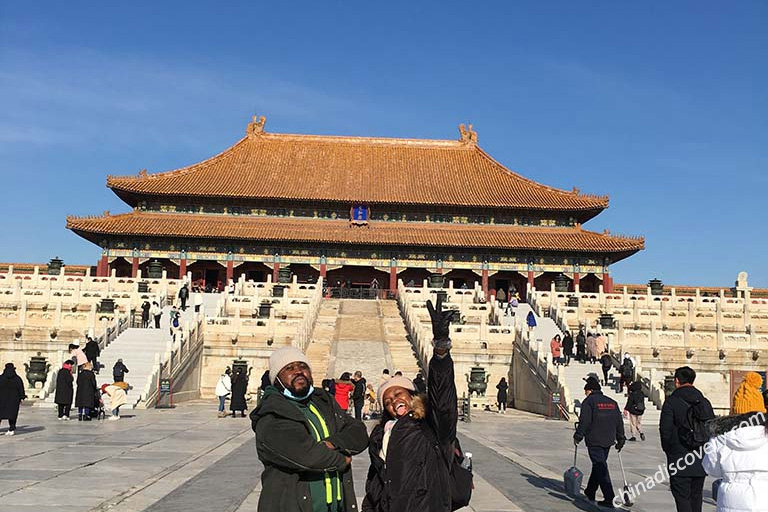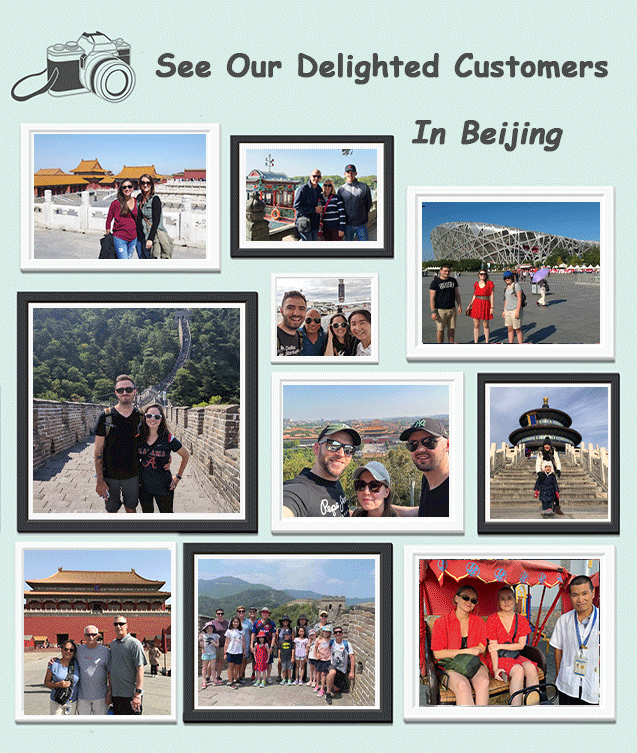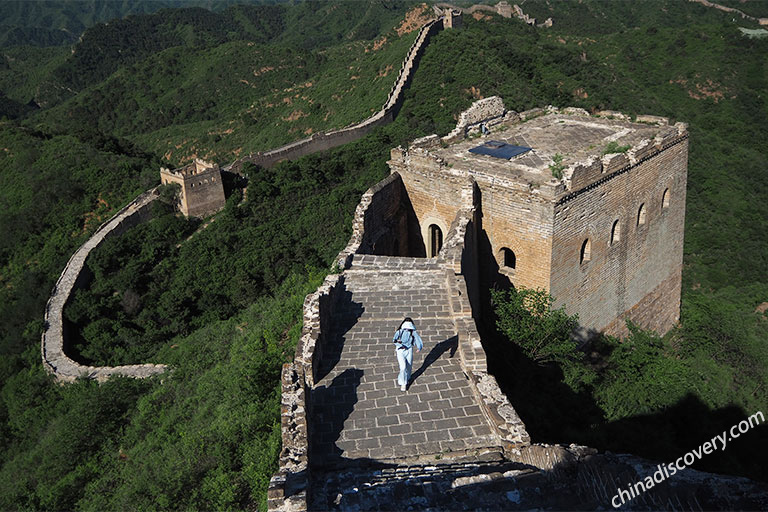Overview of Ming Tombs
In 1421, Emperor Yongle (Zhu Di, 朱棣) moved the capital from Nanjing to Beijing and began to construct the imperial Tombs. The site was chosen with great care and the principle of Feng Shui (风水, a Chinese philosophical system of harmonizing everyone with the surrounding environment) was taken into consideration. Emperor Yongle built the first tomb for himself, and then the subsequent 12 emperors placed their last resting place in the same valley in succession. With time passed by, this cluster of tombs became a key Cultural Protection Unit and a 5A level Scenic Spot. In 2003, UNESCO listed Ming Tombs (明十三陵) in the World Cultural Heritages. In addition to longer history, Ming Tombs enjoy much larger area and the surface structures were also better-preserved.
Layout of Ming Tombs
In fact, Ming Tombs comprises thirteen tombs of emperor, seven tombs of concubines and one tomb of concubines, in covering more than 120 square kilometers. The other tombs are mostly within 8 kilometers away from Changling Tomb. In spite of having own unit and various structures, the tombs share a similar layout with a square yard at the front and a round yard at the back. Each tomb has a huge temple on the ground, and the main architectures were built in the axis, from front to back as follows: Memorial Tablet, Front Arch, Ling’en Gate, Ling’en Palace, Lingxing Gate, Ming Tower and Bao Pavilion etc.
Attractions in Ming Tombs
Nowadays, there are only three tombs are open to public and one tomb was excavated. The main attractions include:
Sacred Way (总神道)
CNY 30 (April 1 to October 31), CNY 20 (November 1 to March 31).
Being the starting point of Ming Tombs, Sacred Way can lead you to Changling Tomb (长陵) and branch into other sacred ways to other tombs. In ancient times, people were not permitted to enter apart from those officials who were responsible to guard these tombs. In the worship day, no one could step into the road on horseback to show great respect to deceased emperors and even the emperor in charge had to dismount.
The Sacred Way begins with the Memorial Arch to Changling Tomb which has five arches propped up by six pillars with pretty carvings of various animals. Round marble tiles combined with upturned corners make the roof rather featured. Passing by the Sacred Way, you’ll meet with the Big Red Gate with three big wooden doors. The central one was for the deceased only and the lateral two were open for the living ones to pay homage. Near to the Big Red Gate stands Tablet House with Huabiao, a marble column, standing at each corner. What makes the sacred much of fun is the avenue of stone animals and statues. Every stone figure has its own auspicious meaning. These stone statues record the precious art of Ming Dynasty and make Ming Tombs a stone carving art Museum.
 Our Guests Visiting Sacred Way
Our Guests Visiting Sacred Way
Changling Tomb (明长陵)
CNY 45 (April 1 to October 31), CNY 30 (November 1 to March 31).
Changling Tomb, the joint burial tomb of Emperor Yongle and Empress Qian, is located in the southern range of Tianshou Mountain. Emperor Yongle has ruled for 22 years, making great progress in political, economic, military, cultural and diplomatic fields. So he was highly estimated among the later generations. Among the thirteen tombs of Ming Dynasty, Changling Tomb is the largest and best-preserved one with longest history. As the first tomb in Ming Tombs, Changling Tomb also becomes the main attraction in this area.
In architecture design, it is square in the front and round in the rear. The whole architectural complex is divided into three parts and main buildings on the central axis still exist. Ling’en Palace in Changling Tomb is the most important building. It is so imposing and majestic that it can be on a par with Taihe Palace in Forbidden City. The skirt-roof is decorated in yellow glazed tiles. The material of the entire beam, column, purlin and other wooden construction are selected from the precious staleproof Nanmu. Except for the plafond, the insider palace is simple and unadorned without any over-colorful painting. There are no existing books about building written in Ming Dynasty or Yuan Dynasty, so the ancient architectures became important mater for historian to learn the style and features of architectures in the two dynasties. Ling’en Palace Tomb is regarded as an indispensable material for study on Ming’s architectures.
Dingling Tomb (明定陵)
CNY 60 (April 1 to October 31), CNY 40 (November 1 to March 31).
Construction of Dingling Tomb started in 1584 and was finished in 6 years later. In 1620, Emperor Wanli (万历皇帝) was buried here with his two empresses. Now, Dingling Tomb is the hottest among the thirteen for it is the only Ming imperial tomb excavated so far. Now it turns to a museum featured with three sections including two exhibition rooms and the Underground Palace.
The first exhibition room displays beautiful jade belt, gold coins, silk fabrics, helmet and sword, and any other jade objects which must widen your horizon. In the second exhibition room, there are many objects of the emperor and his empress or concubines, like phoenix crown, silverware, golden ingots, jade pendants, dressing articles and so on, and full of beautiful things to feast your eyes.
A trip to the Underground Palace gives you a better understanding of the Ming Dynasty art, the tomb structure and the emperor’s extravagance in building the tomb. The total Underground Palace is 1195 square meters and composed of five chambers, the front, middle, rear, left and right annex chambers with distinctive structures. You can learn many interesting knowledge.
 Dingling Tomb
Dingling Tomb
Zhaoling Tomb (明昭陵)
CNY 30 (April 1 to October 31), CNY 20 (November 1 to March 31).
Zhaoling Tomb is located in the east foot Dayu Mountain and here buried the twelfth emperor of Ming Dynasty and his three empresses. After the extinction of Ming Dynasty, Zhaoling Tomb has experienced two large destructions by the war and the heavily rain’s whipping. In Qing Dynasty, the government renovated some tombs including Zhaoling Tomb to ease the racial tensions. Analyzed the relic sites, the archaeologists judged that Ming Tower and Ling’en Palace had been restored during Qing Dynasty. From 1985 to 1960, Zhaoling Tomb had undergone anther renovation and maintenance by Beijing Cultural Relics Bureau. So Zhaoling turns to be the best representation of Ming Tomb Complex. In Ling’en Palace, you can see many offerings and detailed information of the emperor and empresses are provided.
Compared with other two, Zhaoling Tomb is more secluded with fewer visitors, so you can explore the ancient buildings in peaceful environment.
Location & Transportation of Ming Tombs
Located in the northwest of Beijing City and 50 km away from Tiananmen Square, Ming Tombs is not quite easy to get.
- about 15 km away from Juyongguan Great Wall
- about 30 km away from Badaling Great Wall
- about 33 km away from Summer Palace
- about 50 km away from Temple of Heaven
Taking a Subway
Changping Line Subway (昌平线地铁) to Xishankou Station (西山口站)
Taking a Bus
Take Bus No. 872 from Deshengmen (德胜门) directly to the Ming Tombs; Take Express Bus No. 345 from Deshengmen West (德胜门西) to Xihuan South Road (西环南路) and transfer to Bus No. 872, 878, Chang 67. The route and schedule of public transportation are sometimes changeable. Please remember to double check before your trip.
Travel to Ming Tombs with China Discovery - Top Recommended
As the Ming Tombs is located outside the center of the Beijing city, you may encounter troublesome traffic jam or language barriers along your way to there. If you want to get rid of the hustle of public transportation and troublesome navigation, you can book a Ming Tombs tour package that covers sightseeing, dining, lodging, and transfer from us. As part of our valuable Beijing tour packages, our skilled driver and experienced guide will pick you up wherever you are in Beijing including the airport, train stations, and busy scenic areas, etc. It's time-saving and much more safe and you will be escorted all the way to the Ming Tombs with comfortable travelling experience and professional travelling guidance. If you need any help, please feel free to contact us >>
 China Discovery's Local Private Transfer
China Discovery's Local Private Transfer
Attractions around Ming Tombs
Juyongguan Great Wall (居庸关长城)
Juyongguan Great Wall is one of the most-renowned parts of the Great Wall which was built in a 15 kilometers long valley. Here you will have a spectacular view of surrounding mountains with countless peaks, verdant trees and luxuriantly blooming flowers. As the record of one monument built in Ming Dynasty, Juyongguan Great Wall was regarded as the No. 1 Pass in the world . Far back in Jin Dynasty in 800 years before, it was listed in the Eight Great Sights of Ancient Yanjing and praised as “the Emerald Juyong Guan”. Juyongguan is the north portal to Beijing, so it’s quite precipitous and steep that ten thousand are unable to get through even one man guards here.
If you want to admire stunning great wall in Beijing and don't know which sections of the Great Wall to pick, you're highly recommended to check Top 8 Best Sections of Great Wall to Visit.
 Our Guests from Indonesia Visiting Juyongguan Great Wall (2018)
Our Guests from Indonesia Visiting Juyongguan Great Wall (2018)
Taking a Bus
1. Take Bus No.345 from Deshengmen (德胜门) and get off at Shahe Station (沙河站), then transfer to Bus No.68 to reach the scenic spot directly;
2. Take bus No.883 from Deshengmen and get off at Nankou East Street Station (南口东街), then transfer to bus No. 68 to reach the scenic spot directly.
3. Take bus No. 870, 883 or 919 from Deshengmen, get off at Changping South Exit (昌平南口), and transfer to bus No. 879 or Chang 20 to reach Juyongguan Great Wall.
Tips: You can also reach the Ming Tombs by taking bus No. 879 from Juyongguan.
Taking a Subway
Get off at Longze Station (龙泽站)on Metro Line 13 and take bus No.68 to the scenic spot
Silver Mountain Pagoda Forest (银山塔林景区)
Silver Mountain Pagoda Forest is located in West Lake Village, Xingshou Town, Changping District, Beijing. Emperor Tai Zong (627-649) of the Tang Dynasty, esteemed Buddhism and dozens of noted monks came here successively. Years later after the Zen masters and other monks passed away, many pagodas were built to bury them and hence formed Pagoda Forest. Now there are in total of 7 well-preserved pagodas. Two of the pagodas date to the Liao Dynasty (907 AD - 1125 AD), and five date to Jin Dynasty (1115 AD - 1234 AD), presentinf an octagonal structure with exquisitely carved reliefs. The area is characteristic of boundless mountains, grand canyon, and luxuriantly lush pine, cypress, oak trees, which is especially magnificent in Autumn and Winter.
Taking a Bus
Take Chang 31 to Yinshan Station (银山路口).
Warm Tips of Ming Tombs
- Best seasons: Spring and autumn are the best seasons to enjoy the beautiful natural scenery with comfortable weather.
- Opening hours and admission fee for different attractions:
| Attractions | Opening Hours | Admission Fee |
|---|---|---|
| The Sacred Way | 8:00 - 17:30 (Apr. 1 to Oct. 31) 8:30 - 17:00 (Nov. 1 to Mar. 31) |
CNY 30 (Apr. 1 to Oct. 31) CNY 20 (Nov. 1 to Mar. 31) |
| Changling Tomb | 8:00 - 17:30 (Apr.1 to Oct. 31) 8:30 - 17:00 (Nov. 1 to Mar. 31) |
CNY 45 (Apr. 1 to Oct. 31) CNY 30 (Nov. 1 to Mar. 31) |
| Dingling Tomb | 8:00 - 17:30 (Apr. 1 to Oct. 31) 8:30 - 17:00 (Nov. 1 to Mar. 31) |
CNY 60 (Apr. 1 to Oct. 31) CNY 40 (Nov. 1 to Mar. 31) |
| Zhaoling Tomb | 8:00 - 17:30 (Apr. 1 to Oct. 31) 8:30 - 17:00 (Nov. 1 to Mar. 31) |
CNY 30 (Apr. 1 to Oct. 31) CNY 20 (Nov. 1 to Ma. 31) |
| All (The Sacred Way + Changling Tomb + Dingling Tomb + Zhaoling Tomb) |
8:00 - 17:30 (Apr. 1 to Oct. 31) 8:30 - 17:00 (Nov. 1 to Mar. 31) |
CNY 165 | Juyongguan Great Wall | 8:30 - 17:00 | CNY 45 (Apr. 1 to Oct. 31) CNY 40 (Nov. 1 to Mar. 31) |
Silver Mountain Pagoda Forest | 8:00 - 17:00 | CNY 20 (Apr. 1 to Oct. 31) CNY 15 (Nov. 1 to Mar. 31) |
| Outdoor Trip (The Sacred Way + Juyongguan Great Wall + Silver Mountain Pagoda Forest) |
8:30 - 17:00 | CNY 72 |
Ticket fee is for reference only. For up-to-date information, please check the official website of Ming Tombs.
How to Plan Your Travel in Beijing
To explore Beijing's highlights, such as the Forbidden City, the Great Wall (with Mutianyu as the top recommendation), the Temple of Heaven, the Summer Palace, and the Beijing Hutongs - plan for about 4 days, including arrival and departure.
☛ 4 Days Classic Beijing Tour Package
☛ 3 Days Beijing Essential Highlights Tour
If you have extra days, consider hiking the scenic Jinshanling Great Wall, enjoying the stunning night views of Simatai Great Wall, or visiting other sections like Huanghuacheng, Gubeikou, and Juyongguan.
☛ 4 Days Beijing Essence Tour with Simatai Great Wall Night Sightseeing
☛ 4 Days Classic Beijing Tour with Jinshanling Great Wall Hiking
Families with children should not miss Universal Beijing Resort, while museum enthusiasts should visit the National Museum of China, home to the nation's most valuable treasures.
☛ 5 Days Beijing Family-friendly Tour with Universal Studios Fun
☛ 5 Days In-depth Beijing Tour with History and Culture Discovery
As a major transportation hub, Beijing offers easy access to other top destinations in China by flight or train, such as Xi'an, Shanghai, Guilin, Chengdu, and Tibet. China Discovery provides a variety of tour packages from Beijing, or we can customize an itinerary to suit your preferences.
Recommended Beijing Tours with Other Top Cities in China:
☛ 6 Days Classic Beijing Xian High-speed Train Tour
☛ 8 Days Best of China Tour (Beijing - Xian - Shanghai)
☛ 10 Days Classic China Tour from Beijing (Beijing - Xian - Guilin - Shanghai)
We have helped many global travelers enjoy their memorable wonderful trips to Beijing for the past few years. Among them, a special team of over 50 VIPKID teachers from North America traveled with us to see their dear studends in China with amazing experience in Beijing and shared us their special travel story! Travel with China Discovery to create your great China trip memories!
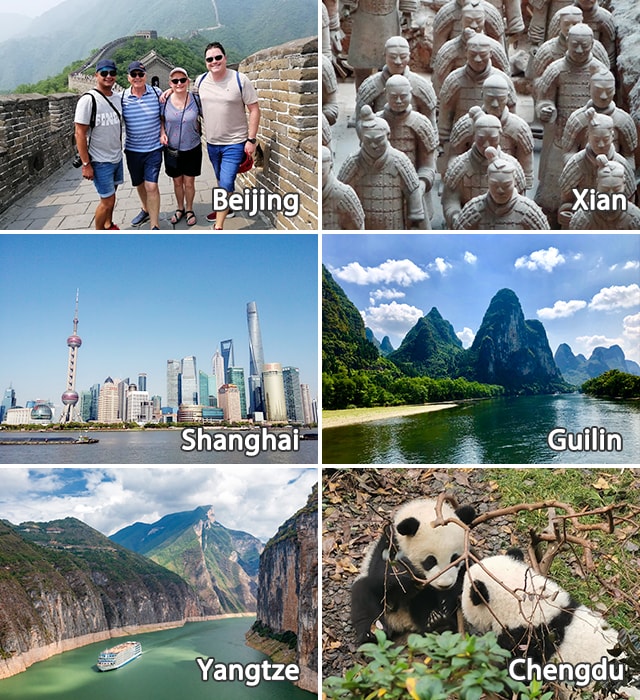 Top China Recommended Destinations
Top China Recommended Destinations
Keep Reading About Beijing Attractions
- Great Wall of China
- Mutianyu Great Wall
- Jinshanling Great Wall
- Forbidden City
- Summer Palace
- Temple of Heaven
- Tiananmen Square
- 798 Art District
- Jingshan Park
- Beijing Hutong
- National Museum of China
- Gubei Water Town
- Lama Temple
- Yandaixie Street
- Nanluoguxiang
- Beijing Central Axis
- Beijing Olympic Park
- Badaling Great Wall
- Huanghuacheng Great Wall
- Simatai Great Wall
- Juyongguan Great Wall
Top Beijing Tours & Travel Guide
- Forbidden City Tours
- Popular Beijing Tours
- Great Wall Hiking Tours
- Beijing Visa Free Tours
- Beijing Layover Tours
- Tpo 6 Beijing Vacations
- Beijing Family Tours
- Beijing Travel Guide
- Beijing Travel Articles
- Great Wall Trip Planning Guide
- How to Plan a Beijing Trip
- Things to do in Beijing
- Top Experiences Recommended by LP
- Featured Activities in Beijing
- How to Get to & around Beijing
- Weather & Seasons in Beijing
- Beijing Maps
- Beijing 144/24 Hour Visa Free
- Recommended Hotels in Beijing
- Beijing Photo Gallery
- Top Beijing Food and Snacks
- Beijing Shopping
- Beijing Nightlife
- Beijing FAQs & Tips
- Forbidden City Travel Tips
- Forbidden City Facts
- Forbidden City Map
- Hall of Supreme Harmony
- Imperial Garden
- Nine-dragon Screen
- The Gallery of Clocks
- The Treasure Gallery
- Palace Museum Collections
- How to Visit the Forbidden City
- Forbidden City Photography Tips
- Forbidden City Weather & Seasons
- How to Book Forbidden City Tickets
- How to Get to Forbidden City
- How to Transfer from Beijing Airports
Recommended Beijing Tours
Top 3 Beijing tours chosen by most customers to explore Beijing in the best way. Check the detailed itinerary, or tailor your own trip now with us.
Start planning your tailor-made holiday to China by contacting one of our specialists. Once inquired, you’ll get a response within 0.5~23.5 hours.
Customize a TripHave a question? Get answers from our travel experts or guests
- Your Question:
- Your Name:
- Your Email:
- Submit


























